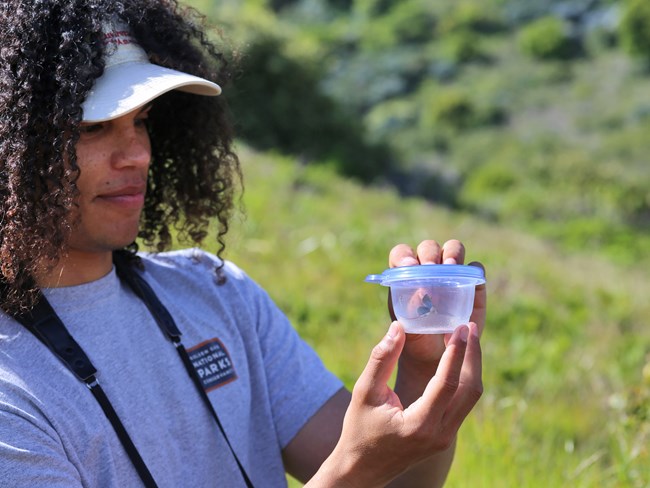Last updated: June 14, 2023
Article
Mission Possible: Second Year of Sweeney Ridge Mission Blue Butterfly Reintroductions a Success

NPS / Ivan Bossert

NPS / Aiko Goldston
May 2023 - Mission blue butterflies are back to their old flying grounds. In a fight to restore the federally endangered butterfly’s resilience, National Park Service staff and partners have been working to boost populations that shrunk or vanished through the decades, like that at Sweeney Ridge.
This spring marked the second year of Mission blue reintroductions at Sweeney Ridge. Scientists successfully translocated their quota of 40 female and 20 male butterflies. Last year, they translocated 57 butterflies, but prior to that, the Mission blue butterfly was last seen at Sweeney Ridge in 1987.
Adult Mission blue butterflies began emerging in early April this year. Scientists observed them flying at Sweeney Ridge even before beginning translocations. According to Golden Gate Wildlife Ecologist Bill Merkle, this confirms that the butterflies reintroduced last year reproduced and the translocation is working.
After a year of growth as larvae, adult Mission blue butterflies have just over a week to show off their shining wings, find a mate, and lay their tiny, pearly-white eggs. With no time to waste, scientists got to work translocating them from San Bruno Mountain — which has the largest population — to Sweeney Ridge.
On a schedule that mimics the short lifespan of adult butterflies, biologists can translocate from San Bruno Mountain every seven to 10 days. This year, the fog lifted on most collection days. The sunlight allowed the Mission blues to bask out in the open and warm up enough to take flight — helping translocation teams to find them.
The life of a Mission blue butterfly revolves around its host plant. Throughout its year-long life cycle, lupine serves as the Mission blue’s shelter under which to hibernate, its sustenance, the place to lay its eggs. Because of these tight ties, project partners began restoring habitat at Sweeney Ridge in 2019 to prepare for the butterfly’s reintroduction. They removed intruding scrub and planted silver lupine (Lupinus albifrons) and summer lupine (L. formosus).

NPS / Stephanie Ibarra

NPS / Matt Millado
The two sites at Sweeney Ridge where butterflies are released now contain primarily silver lupine. But silver lupine is susceptible to a fungal pathogen, which in some years has decimated large portions of the plant’s population. Scientists have hypothesized that this pathogen is what caused the lupine population, and therefore the Mission blue butterfly, to blink out at Sweeney Ridge.
Summer lupine, on the other hand, is not affected by the fungus. So, to improve resilience in case of another outbreak, ecologists have seeded it into the site’s Mission blue habitat as well. Since it isn’t easy to coax summer lupine seeds into establishing, they hope to create a seed amplification plot—where the plant is farmed with the purpose of collecting seeds—this fall. Seeds from the amplification will be used at both Sweeney Ridge and Milagra Ridge, Biologist Eric Wrubel said.
After bringing butterflies to Sweeney Ridge, project scientists monitor lupines for eggs until the beginning of June. Monitoring also occurs at the other park sites where the butterfly resides. If scientists find enough eggs this year at Sweeney Ridge, only one more year of translocations may be needed to establish a robust, self-sustaining Mission blue population.
For more information
- Check out the Pacific Coast Science and Learning Center's Mission Blue Butterfly page
- Contact Golden Gate National Recreation Area Biologists Bill Merkle or Eric Wrubel
See more from the Bay Area Nature & Science Blog
